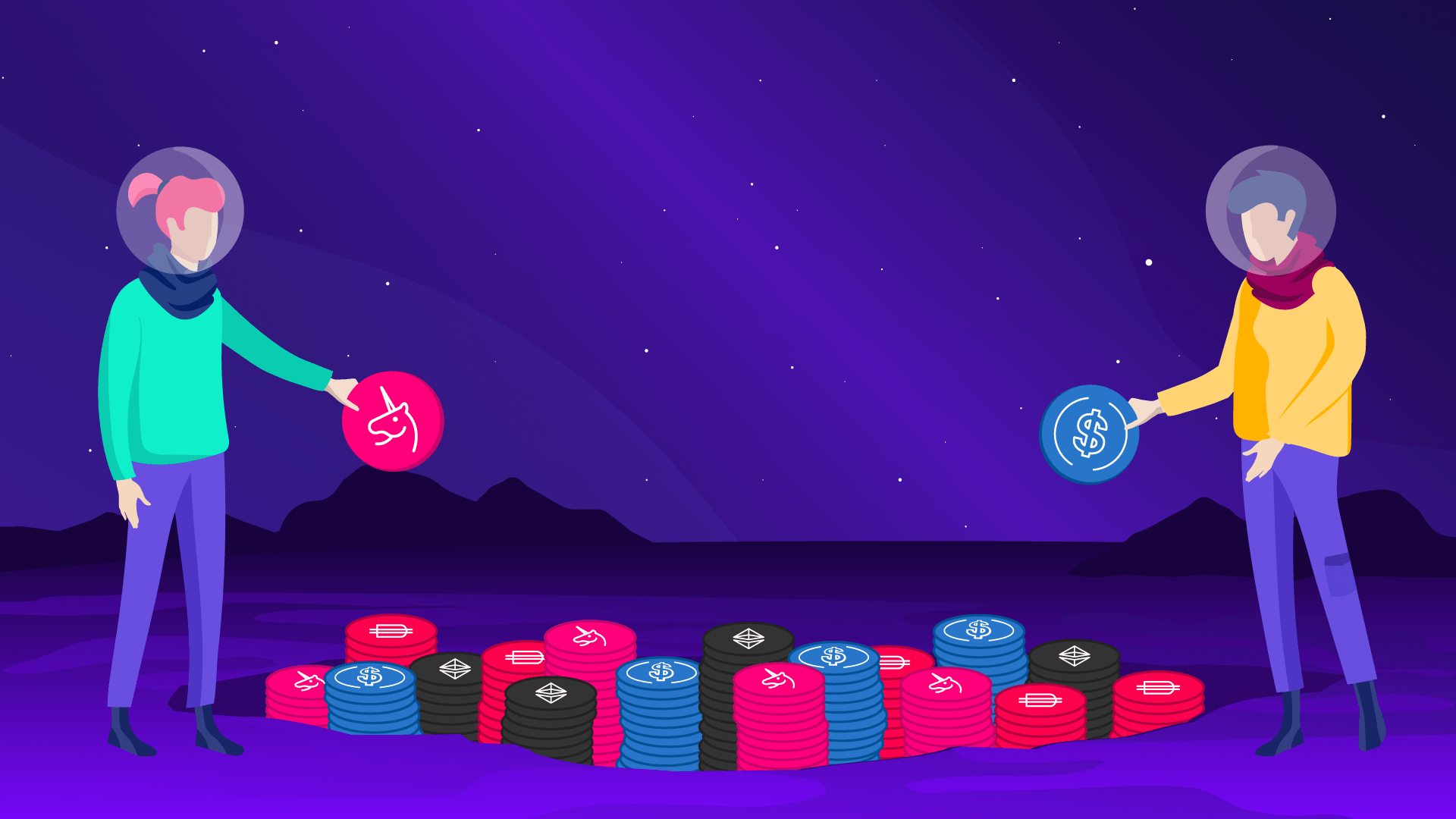Decentralized exchanges, a fundamental and simple tool for trading and swapping cryptocurrencies, without intermediaries and in an automated manner.


Among other things, dexes allow automated exchanges to be made, based on funds contributed by users.
Dapps, decentralized applications
Cryptocurrencies revolutionized the way we understand money. But the evolution of blockchain technology gave rise to many other types of resources that go beyond monetary use.
Being able to create software that runs on blockchain opened up a world of opportunities for developers, companies, and enthusiasts. These applications are known as dapps, or decentralized apps.
Decentralization is a fundamental characteristic to not depend on any control or intermediary. Therefore, dapps are programs that are open and accessible to everyone, and do not require central servers.
While standard software is created and controlled by a company or entity, a “central authority” that can change its terms and conditions at any time, on the other hand, in dapps the entire process is visible, open, and often even hidden. put to vote.
In fact, these apps can be audited since their open source is available to the general public to know how they work and what they do with our data and funds.
The Uniswap case
January 16, 2022
Decentralized exchanges and automated token markets. UNI, the native token of Uniswap. How dexes work and what you can do in them.

One of the most significant DeFi projects is the decentralized exchange Uniswap, which works similarly to any exchange where users can trade peer-to-peer, but with a decentralized infrastructure.
The positive thing about dexes like Uniswap is that control of the funds is always in the hands of the user. And, furthermore, due to the platform’s large base of users and liquidity providers, there is increasingly a faster response for exchanges.
In the early days of DeFi, liquidity crises could occur when services were not able to meet market demand. This happened because it was very difficult for the dexes to have the required large amounts available when a DeFi token started to give good returns and everyone wanted to switch to it.
Until 2018, Uniswap appeared, which works based on automated ERC-20 token markets: with this and other similar dexes, the DeFi community can trade with lower terms and commissions: take DAI and convert them to ETH, for example, or spend from LINK to USDC. Additionally, Uniswap has its own token, UNI, which is one of the top 10 tokens in the market.

How Uniswap and other dexes work
Just as a user can exchange their crypto for others on Uniswap (a process known as “swapping”), so can the rest of the ecosystem. Even large projects with a large number of tokens to exchange. Therefore, Uniswap has to be able to respond to that demand so that anyone can exchange their cryptocurrencies.
To do this, dexes encourage adding tokens and cryptocurrencies to a liquidity pool where funds are pooled. In Uniswap, it is not even necessary for everyone to put in the same type of asset. One person can put Dogecoin, another a stablecoin like USDT, and another even UNI, Uniswap’s own token. All this works through smart contracts, without the user having to do anything. That is why they are known as automated markets.
These liquidity pools are something similar to “making a little cow” of available funds, where one person puts in as much, another as much, another person another amount, and so on. Depending on the type of asset and the amount that is added to the pool, it is the reward that is obtained: the performance. In that sense, it is like depositing money for a fixed term whose conditions are established in smart contracts, and are transparent and infallible.
There are several ways to deposit that money. Dexes provide availability of tokens and cryptocurrencies for exchange. Lending protocols generate funds for the sector. In both cases, in general you must deposit the same amount (in dollars) of a pair of tokens, for example ETH and UNI.
The contribution to the pools in general gives performance depending on the amount of movement that occurs in the pair. This means that a part of the commission that is generated in the dexes as a cost to trade crypto is transferred to whoever contributed funds to that pool. If someone transfers their ETH to UNI, those users who have contributed liquidity to the ETH/UNI pair collect part of that fee.
While staking involves “locking” a certain amount of a specific token in exchange for a return or “interest.” It is much more similar to a fixed term, where that profit is given depending on how long we leave our funds deposited. Please note that staking can be stopped at any time, and performance collected up to that point.
The AAVE case
La importancia de los pools de liquidez en los protocolos de préstamos cripto. La historia de AAVE, la red emblema de las finanzas descentralizadas.

AAVE is a crypto loan protocol and market with which investors can contribute funds by “depositing” their cryptocurrencies, and in exchange obtain an income from commissions for operations carried out on the platform.
It appeared in June 2017, under the name ETHLend, as a project designed by Stani Kulechov to generate a decentralized lending market based on smart contracts. The protocol was very inspiring, and gave rise to much of the DeFi ecosystem.
Shortly after, in September 2018, ETHLend grew, established itself as an automatic liquidity market, added features, rebranded to AAVE, and launched its own ERC-20 token.
AAVE works around a crypto liquidity pool, a “pool” or “well” where various users can contribute crypto assets. Thus, the project secures funds to make more loans, while these “liquidity providers” can profit from the interest that the platform generates every time it lends those cryptocurrencies.

“Liquidity pools” allow dex users to earn on their deposits or borrow tokens.
Lending/borrowing protocols
AAVE is a protocol that allows you to borrow cryptocurrency instantly. Or take out a loan and earn interest on it. And since all major protocols are based on Ethereum, it means you can lend or borrow any ERC-20 token.
This entire procedure is non-custodial, meaning that the teams on the various websites and apps they are currently using do not have any permitted use of my data.
Keep in mind that not even DeFi applications require intermediaries or arbitrators. The smart contract code specifies the resolution of any potential dispute, while users maintain control over their funds at all times. This reduces the cost of operating, and facilitates a frictionless financial system.
All of this collaborates so that DeFi is consolidating itself as a truly international movement, with open source services, and as a technological and economically accessible possibility for everyone. As these protocols are mounted on public blockchains, they can present the guarantee of cryptographic verification methods. Blockchain lending marketplaces reduce counterparty risk; and they make it cheaper, faster and more available to more people to take and grant loans.

